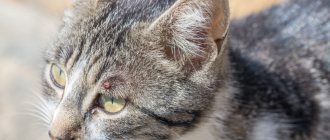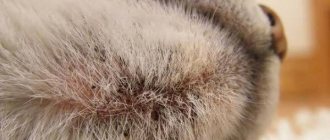The so-called periaucular alopecia (the appearance of characteristic bald patches near the ears) is a common phenomenon in many cats. Other signs of skin pathologies are often absent. Most often, symptoms of alopecia appear in cats with short hair; itching is completely absent.
Alopecia, as a rule, is heterogeneous in nature, covers the entire ear area, and can spread to other areas of the animal’s skin. We will discuss further why this pathology occurs.
The appearance of receding hairline: reasons
The area of the skin where hair has fallen out is called a receding hairline; such a change is not normal and can appear for various reasons, including:
- Allergic reaction to food, medications.
Allergies to food (industrial feed, lamb, cereals), medications often develop in cats. Signs of the pathological condition: baldness of the skin near the ears and eyes, on the stomach, constant itching, redness of the bald areas.
- Endocrine alopecia.
Hair loss may indicate hormonal imbalances in the animal’s body, indicating the development of diseases such as: pathologies of the thyroid gland, diabetes mellitus, malfunction of the adrenal glands, malfunctions of the internal glands. Additional signs of hormonal imbalance are: excessive drinking of water, frequent urination, sudden weight loss.
- Parasites.
Hair loss can occur if the cat is infected with ringworm. Infection occurs through contact with a carrier of parasites; the disease may not manifest itself for a long time. Subcutaneous mites begin to actively develop if the pet’s immunity is weakened.
Additional symptoms: flaky skin, the formation of bleeding wounds, ulcers above the eyes. Fleas can also cause baldness, biting parasites bother the animal, the cat begins to intensively scratch the skin, as a result of which the hair roots become weak and the hair falls out.
- Scabies, lichen.
Be sure to read:
Why does a cat shake its ears and head constantly, causes of itching, how to help and what to do
Bald spots may indicate the development of infectious diseases, such as lichen or scabies.
Fleas
The saliva left behind after a cat is bitten by a flea causes an itchy reaction that makes cats itch like crazy. While hair loss can occur anywhere on the body, the hair on a cat's head, face, and ears are especially vulnerable to hair loss when cats rub against furniture and rugs in an attempt to find some relief. Fleas can be easily identified by their physical presence or by the small droppings they leave behind in your cat's fur. Infestations can be treated with a number of insecticidal products, including sprays, shampoos and spot treatments such as Frontline for cats.
How to distinguish normality from pathology?
Baldness of skin areas is not always caused by pathological reasons. In some cases, hair loss occurs in cats that have recently given birth to kittens. The problem arises due to an unbalanced diet. A nursing mother needs increased nutrition and vitamin intake.
In animals of smooth-haired breeds, bald spots can occur as a result of regular licking of the fur, due to genetic predisposition.
Hair loss may indicate nervous strain that has arisen in the cat as a result of moving or having a new pet. Such situations are stressful for the pet; treatment is by taking sedatives.
Vitamin deficiency can be another reason for hair loss.
Why does baldness occur?
There are many factors that provoke the manifestation of alopecia. Most often, this phenomenon occurs in short-haired cats. Before moving directly to the treatment of pathology, it is necessary to understand what caused the disease. The most common cause of a receding hairline is food allergies. Most often, cats are allergic to foods such as lamb, cereals, and proteins of plant or food origin. By adjusting your pet's diet, you can improve its health.
Hormonal imbalance can also cause the formation of bald spots in a cat. In this case, hair falls out not only in the ears or around the eyes, but also in other areas. With hormonal imbalance, baldness occurs in the abdomen, chest, hind legs, armpits, and also in the area near the anus.
Stress can trigger baldness in cats. When the cause of a skin disease is a psychogenic factor, the cat may also begin to lose hair in the abdomen, thighs and inner surface of the paws. In this case, the owner needs to provide his pet with the most peaceful living environment possible. Calming medications intended for cats will also have a beneficial effect on the health of your four-legged friend.
Alopecia sometimes results from dermatomycosis. In this case, increased hair loss is noticed in the area of the eyes and ears. The shape of bald patches with dermatomycosis is ring-shaped or rounded. In problem areas, the skin is quite dry, however, the cat is not bothered by itching. The cause of the development of dermatomycosis is fungal diseases that negatively affect the epidermis and fur of the pet. Treatment of bald patches in cats is carried out using special antifungal agents.
Bald patches near the ears
The development of characteristic bald spots near the ears of an animal (periacular alopecia) occurs in a cat for the same reasons as hair loss above the eyes.
To make a diagnosis and prescribe treatment, your pet should be taken to a veterinary clinic, where the doctor:
- will conduct a visual inspection,
- will prescribe a series of tests,
- take scrapings from the skin,
- Based on the data obtained, he will prescribe treatment.
Diagnosis of the disease
If adult family members or your pediatrician notice signs of alopecia, you need to understand why your hair is thinning. For this purpose, extensive diagnostics are carried out. To treat alopecia, a child should first visit the following pediatric specialists:
- dermatologist;
- trichologist;
- endocrinologist;
- gastroenterologist;
- neurologist.
These doctors will prescribe a series of examinations to determine the cause of the pathology:
- Gastrointestinal examination. It may include tests for Helicobacter pylori (a stomach bacterium that causes gastritis) using PCR and ELISA methods, stool analysis for dysbacteriosis, ultrasound of the abdominal organs, as well as fibrogastroduodenoscopy (FGDS).
- An endocrinologist may prescribe a blood test for the level of thyroid hormones (AT, TSH, etc.), cortisol, the level of ionized calcium, and ultrasound of the thyroid gland.
- To determine the microelement status of a child, a spectral study of hair and blood is performed to determine the content of microelements.
- ELISA diagnostics allows you to detect antibodies to herpes, hemolytic streptococcus, helminths, Giardia, and fungi.
- The trichologist prescribes a trichogram, computer diagnostics of the scalp, and phototrichogram.
- In clinically unclear cases, a scalp biopsy is performed followed by histology. This is necessary to exclude cicatricial alopecia, which is a symptom of lichen planus and systemic lupus erythematosus.
- If there is doubt about the diagnosis, the child may be referred for consultation to a mycologist.
- Rheoencephalography is indicated for common forms of baldness; it allows one to exclude disturbances in blood flow in the cerebral veins.
The appearance of bald patches: what to do
A cat owner who notices the appearance of bald spots should not self-medicate. The pet should be taken to a veterinarian to determine the cause of the illness. The doctor will conduct an examination and prescribe adequate treatment.
Prevention measures:
- feeding with quality feed,
- regular hygiene procedures,
- timely vaccination of the animal,
- taking vitamin complexes,
- regular checkups with a veterinarian.
Be sure to read:
A cat has a lump under the skin on its stomach: what is it, causes and treatment, what to do if it festers
Prevention measures
To avoid hair problems, you need to follow these recommendations:
- choose high-quality food that matches the condition and age of the cat;
Give your pet antihelminthics at intervals of three months;- regularly treat the animal for fleas;
- eliminate all factors that can lead to the development of allergies;
- vaccinate in a timely manner;
- provide your pet with complete care.
Why does baldness occur?
There are many factors that provoke the manifestation of alopecia. Most often, this phenomenon occurs in short-haired cats. Before moving directly to the treatment of pathology, it is necessary to understand what caused the disease. The most common cause of a receding hairline is food allergies. Most often, cats are allergic to foods such as lamb, cereals, and proteins of plant or food origin. By adjusting your pet's diet, you can improve its health.
Hormonal imbalance can also cause the formation of bald spots in a cat. In this case, hair falls out not only in the ears or around the eyes, but also in other areas. With hormonal imbalance, baldness occurs in the abdomen, chest, hind legs, armpits, and also in the area near the anus.
Stress can trigger baldness in cats. When the cause of a skin disease is a psychogenic factor, the cat may also begin to lose hair in the abdomen, thighs and inner surface of the paws. In this case, the owner needs to provide his pet with the most peaceful living environment possible. Calming medications intended for cats will also have a beneficial effect on the health of your four-legged friend.
Alopecia sometimes results from dermatomycosis. In this case, increased hair loss is noticed in the area of the eyes and ears. The shape of bald patches with dermatomycosis has a ring-shaped or rounded shape. In problem areas, the skin is quite dry, however, the cat is not bothered by itching. The cause of the development of dermatomycosis is fungal diseases that negatively affect the epidermis and fur of the pet. Treatment of bald patches in cats is carried out using special antifungal agents.
Features of treatment
You can eliminate bald patches in a cat above the eyes or in another problem area by addressing the root cause of the disease. If parasites are the cause of the skin disease, it is necessary to provide the pet with proper treatment. The use of special ointments, gels and sprays that effectively affect parasites will help improve the condition of your pet. The cat owner should give the animal vitamins that will increase its immunity.
If local baldness occurs as a result of allergies, then it is necessary to limit contact with allergens. A hypoallergenic diet will improve your cat's health. In this case, the veterinarian prescribes the animal to take antiallergic drugs and immunostimulants.
When an animal has problems with the endocrine system, then it is recommended to select special treatment. Taking hormones will improve the cat's health and return its coat to its previous appearance.
Preventive measures
Preventing skin disease such as alopecia is not difficult. To do this, you must adhere to the following measures:
- Observe hygiene rules. The owner must remember to inspect the cat’s fur (especially if he is often outdoors) for ticks and other parasites and deal with them in a timely manner;
- Provide the animal with a balanced diet. The cat's diet should contain vitamins and other useful microelements;
- Carry out routine vaccinations for your pet;
- Visit the veterinarian periodically. During the examination, a specialist can identify possible pathologies;
There is no need to “sound the alarm” if your beloved cat has bald patches on his skin. This phenomenon is not uncommon for most cats. If you find the cause of the pathology in a timely manner and carry out treatment, it is easy to return your pet to vigor and health.
Features of treatment
You can eliminate bald patches in a cat above the eyes or in another problem area by addressing the root cause of the disease. If parasites are the cause of the skin disease, it is necessary to provide the pet with proper treatment. The use of special ointments, gels and sprays that effectively affect parasites will help improve the condition of your pet. The cat owner should give the animal vitamins that will increase its immunity.
If local baldness occurs as a result of allergies, then it is necessary to limit contact with allergens. A hypoallergenic diet will improve your cat's health. In this case, the veterinarian prescribes the animal to take antiallergic drugs and immunostimulants.
When an animal has problems with the endocrine system, then it is recommended to select special treatment. Taking hormones will improve the cat's health and return its coat to its previous appearance.
Preventive measures
Preventing skin disease such as alopecia is not difficult. To do this, you must adhere to the following measures:
- Observe hygiene rules. The owner must remember to inspect the cat’s fur (especially if he is often outdoors) for ticks and other parasites and deal with them in a timely manner;
- Provide the animal with a balanced diet. The cat's diet should contain vitamins and other useful microelements;
- Carry out routine vaccinations for your pet;
- Visit the veterinarian periodically. During the examination, a specialist can identify possible pathologies;
There is no need to “sound the alarm” if your beloved cat has bald patches on his skin. This phenomenon is not uncommon for most cats. If you find the cause of the pathology in a timely manner and carry out treatment, it is easy to return your pet to vigor and health.
I graduated from the National State Agricultural Academy and have been working as a veterinarian for 8 years.
In my free time, I write articles about the diagnosis and treatment of cats.
Feel free to ask questions in the comments, I will try to answer everything.
Quite often, baldness around the eyes of a cat can be associated with seasonal shedding, which lasts 1-2 weeks. If this process is prolonged or accompanying symptoms appear, then the option of molting disappears and you should think about possible problems with nutrition (incorrectly selected food often causes food allergies), parasites or bacterial infection.









